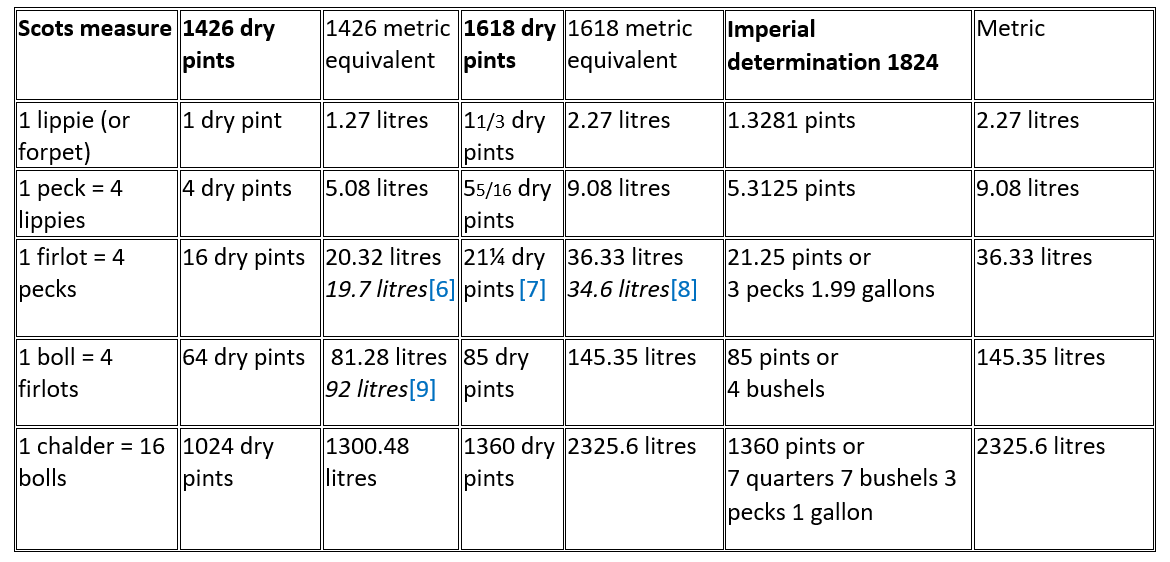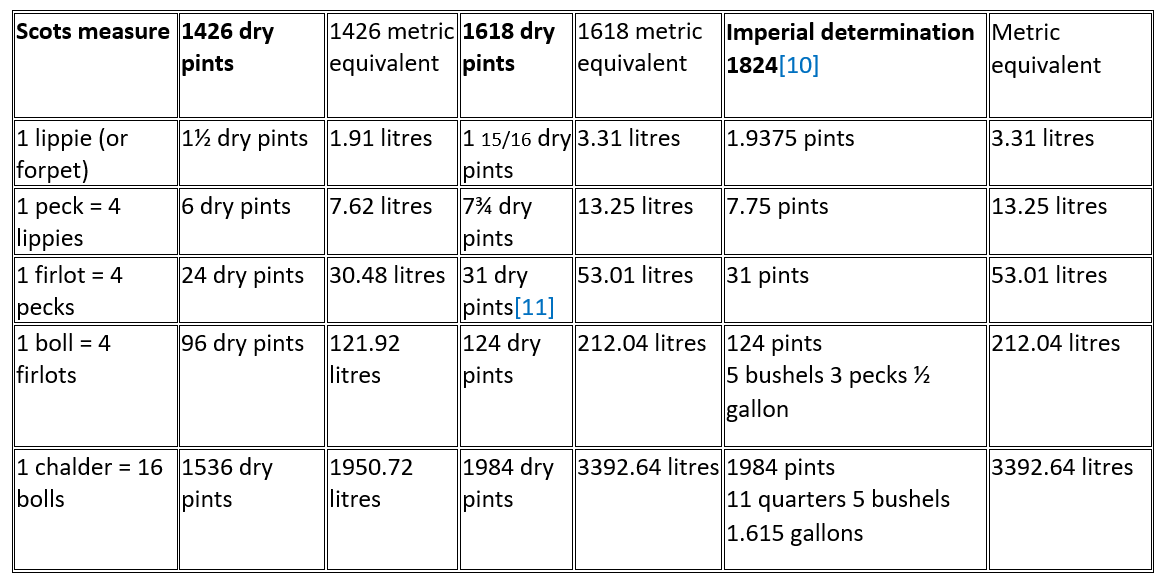Weights & measures – dry capacity
The main units of dry capacity were the boll (from the word ‘bowl’) and the firlot (a ‘fourth lot’), which was a quarter of the boll. A quarter of the firlot was a peck (possibly from the word ‘pack’ or else from the French picotin, meaning a ‘peck’, or the Latin picotus, a liquid measure). A quarter of a peck was a forpet (a corruption of ‘fourth peck’) or lippie (from the Anglo-Saxon leap, meaning a ‘basket’). Sixteen bolls made a chalder or chaldron (from the French chaudron, meaning a ‘kettle’).
There were two variants of lippies, pecks, firlots, bolls and chalders, depending on what was being measured: wheat measures and barley measures. According to Connor and Simpson, the barley measures were based on ‘3 fills of the wheat firlot for 2 firlots of barley’ until 1618 when separate firlots were made for barley measures. There was also a heaping allowance of an additional 1/16th for merchants conducting transactions in the markets.[1]
The firlot was defined by the Scots Parliament in terms of the number of pints it held. The number of pints in both wheat and barley firlots and bolls were increased at the parliamentary assizes of weights and measures in 1426 and 1618. The size of a pint was increased in 1426 and c. 1500. (See the Knowledge Base entry on Weights and Measures: Scottish Liquid Capacity for more details.)
The tables of dry capacity should be regarded as guidance only and the bibliography should be consulted for more precision. They have been calculated from the pint and are based on the information in Connor and Simpson that in 1426 1 pint = 1.27 litres and in 1618 1 pint = 1.71 litres.[2] However, the physical standards examined by Connor and Simpson suggest alternative capacities which are shown in italics in these tables.[3] Imperial measurements are taken from Buchanan’s Tables.[4] Metric equivalents were rounded to two decimal points.[5] The heaping measures are not shown.
- For wheat, peas, beans, meal, etc.
- For barley, oats, malt, etc.
Further information on Scots measurements can be found in the Dictionaries of the Scots Language <https://dsl.ac.uk/> [accessed 24 April 2024].
Compilers: SCAN contributors (2000). Editor: Elspeth Reid (2021)
Related Knowledge Base Entries
Weights and measures: origins of weights and measures in Scotland
Weights and Measures: Scottish Distance and Area
Weights and Measures: Scottish Liquid Capacity
Weights and Measures: Scottish Weight
Bibliography
Buchanan, George, Tables for Converting the Weights and Measures Hitherto in Use in Great Britain…also Abstracts of the Jury Verdicts throughout Scotland in Regard to the Weights and Measures of Each County (Edinburgh 1829)
Connor, R. D., and A. D. C. Simpson, Weights and Measures in Scotland: A European Perspective, ed. by A. D. Morrison-Low (NMSE, 2004)
References
[1] R. D. Connor, and A. D. C. Simpson, Weights and Measures in Scotland: A European Perspective, ed. by A. D. Morrison-Low (NMSE, 2004) p. 754.
[2] Connor & Simpson, Weights and Measures in Scotland pp. 753-54.
[3] Connor & Simpson, Weights and Measures in Scotland p. 754.
[4] George Buchanan, Tables for Converting the Weights and Measures Hitherto in Use in Great Britain […] also Abstracts of the Jury Verdicts throughout Scotland in Regard to the Weights and Measures of Each County (Edinburgh 1829), pp. 40, 140-42, 151-52.
[5] Connor & Simpson, Weights and Measures in Scotland p. 753.
[6] Connor & Simpson, Weights and Measures in Scotland p. 754.
[7] Connor & Simpson, Weights and Measures in Scotland p. 753.
[8] Connor & Simpson, Weights and Measures in Scotland p. 753.
[9] Connor & Simpson, Weights and Measures in Scotland p. 754.
[10] Buchanan, Tables for Converting the Weights and Measures p. 40.
[11] Connor & Simpson, Weights and Measures in Scotland p. 754.



